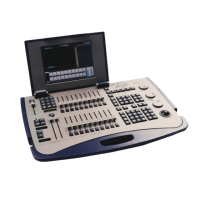Programming Memories
Spark
4-5
Programming Memories
1. Select channels using the numeric keypad.
2. Assign intensity using the dimmer wheel or press [@] and assign an intensity
value using the numeric keypad.
3. Select spots using the numeric keypad.
4. Assign parameter values. Use the parameter wheels or select a parameter on the
Soft Keys and assign a value on the numeric keypad. (Use the [STEP UP] and
[STEP DOWN] keys for discrete and mixed step parameters).
5. Select a scroller channel.
6. Assign a scroller frame using the parameter wheel 2 or press [FRAME] and assign
the frame using the numeric keypad.
7. Press [MEMORY] or press [=]. (See Special Functions in Chapter 26.)
8. Enter the memory number using the numeric keypad.
9. Make fade time assignments by selecting the time in, time out, wait in, wait out, or
delay and entering the time assignment on the numeric keypad.
Press [TIME #] for time in.
Press [TIME] [TIME #] for time out.
Press [WAIT #] for delay.
Press [WAIT] [WAIT #] for wait in.
Press [WAIT] [WAIT] [WAIT #] for wait out.
10. Press [STORE].
11. Press [RESET] to clear the editor or continue editing without resetting the editor.
See Chapter 7 - Programming Memories, for further information.
Playback Memories on A/B
1. Select a memory by pressing [MEMORY] and the memory number.
2. Press A or B. It is recommended to assign the memory to the inactive fader; if the
fader is at A assign the memory to B, if the fader is at B assign the memory to A.
3. Move the fader so the memory is active on stage.
4. Press [SEQ]. The next memory is now on board.
5. Press [GO] to begin the crossfade from the active memory to the memory on
board.
See Chapter 11 - The Crossfaders, for further information.

